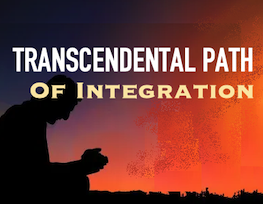
The Transcendental Path of Integration
From Vision to Embodiment – Living the Union of Transcendence and Presence

From Vision to Embodiment – Living the Union of Transcendence and Presence
Throughout my life I’ve made a conscious effort to seek and embrace experiences of the transcendent. I am not alone. Throughout human history, seekers have reached beyond the ordinary, moments of expanded awareness, mystical union, and profound insight into the nature of reality.
These are experiences that lift us beyond the boundaries of the self, dissolving the usual lines between inner and outer, time and timelessness, self and cosmos. Yet the true challenge is not only to glimpse the transcendent, but to return with it, to live it, to embody it, to allow its wisdom to transform daily life.
There are moments when life cracks open and we glimpse something beyond the ordinary. It might happen in stillness, in ritual, in the sweep of nature’s beauty, or in the rhythm of the drum. In those moments, time loosens its grip, the edges of self blur, and we sense we are part of something vast and luminous.
But transcendence alone is not enough. Without integration, even the most profound experience can fade into the background, or worse, possibly a source of imbalance that alienates us from ordinary reality.
As we look at the dance between transcendence and integration, it’s easy to continue seeking only the high of transcendent experience, rather than doing the steady work of weaving those insights into life. The path of integration asks not just for memory, but for practice.
This is the essence of how I see the Transcendental Path of Integration: the weaving together of higher states of awareness with the ordinary flow of our embodied experience.
Many traditions describe a journey beyond and back again. In shamanic practice, one travels into the spirit world and returns with guidance for the community. In mystical Christianity, transcendence is the ecstatic and intimate union with God. In Buddhism, moments of awakening are not ends in themselves but invitations to walk each step with compassion and presence. In Jewish mysticism, transcendence and integration are held in dynamic relationship at the heart of spiritual life.
At their core, these traditions share a common truth: integration is the work of assimilating the profound encounter with the transcendent into everyday life, allowing it to transform the self and, through us, the world, all through the lens of divine love.
States of transcendence connect us to peace, unconditional love, and the radiance of this mystical universe. They also connect us to our bodies, to one another, and to the natural world in ways we may never have experienced before. Such moments offer direct understanding of inner wisdom and the interconnectedness of creation. But transcendence alone is not enough. Integration ensures that the wisdom of transcendence does not remain an abstract memory but becomes embodied.
This idea of a transcendental path of integration is not a single event but an ongoing journey. In my own life, I’ve found that each time I bring a transcendent insight into embodied practice, the distance between spirit and matter, vision and action grows smaller. Over time, the extraordinary becomes natural, and the ordinary reveals its own extraordinary nature.
Lasting integration requires practice. Ancient and contemporary traditions alike remind us that spiritual states can be cultivated, stabilized, and embodied through disciplined, rhythmic engagement.
At the Cuyamungue Institute, our practice of Ritual Body Postures is a doorway into expanded states of awareness. This practice offer not only access to transcendence but also a grounded way to carry its insights into daily life. As an embodied practice, it becomes the bridge between vision and embodiment, between transcendence and integration.
Integration brings about a synthesis where something new can emerge. Transcendence is often temporary, but when woven into daily life, it can transform who we are and how we live. Both transcendence and integration have their place, and together they form a path of deep transformation.
The Transcendental Path of Integration is about becoming fully alive, bringing the infinite into the finite, and in doing so, realizing the wholeness we already are.
“Transcendence alone is not enough. Integration ensures that the wisdom of transcendence does not remain an abstract memory but becomes embodied"
Paul Robear Tweet

The name “CUYA” carries with it both history and vision. Rooted in our origins as the Cuyamungue Institute, it now also serves as an acronym — C.U.Y.A. — a guiding symbol that unites our mission:
C — Consciousness: The field of shared awareness that arises in Collective Presence, where the “We” awakens beyond the “I” – moving from the “Me to the We.”
U — Unity: Our alignment with the Cycles of Nature and the rhythms of the cosmos, reminding us that we are woven into a greater fabric of reality. This sense of unity reminds us that our awareness is the shared consciousness that connects all living beings.
Y — Your Awakening: The inner journey of Embodiment and Wisdom, where through direct experience the body remembers. At the CUYA Institute, this awakening is nurtured through Ritual Body Postures and ecstatic trance, where the body itself becomes the doorway to wisdom, presence, and transformation.
A — Ancestral Wisdom: Roots. Our connection to Sacred Lineage, honoring those who walked before us and rooting us in belonging and continuity. Our founder, anthropologist Felicitas D. Goodman looked to some of the oldest, most authentic ancestral records we have — the world’s collection of early and indigenous art — and decoded selected artifacts as embodied “ritual instructions.”